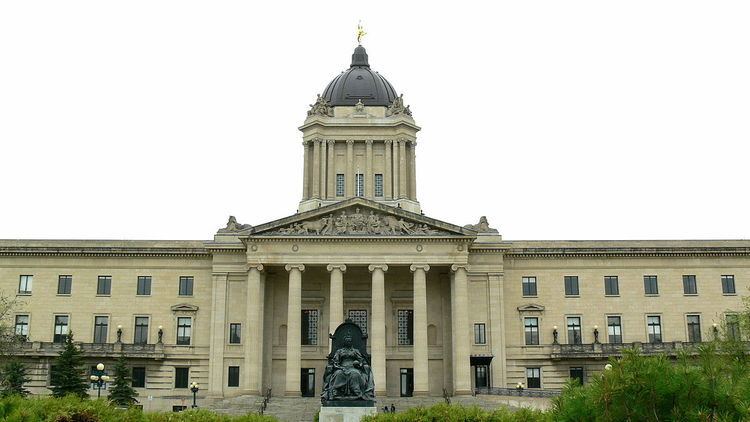 | ||
Manitoba is governed by a unicameral legislature, the Legislative Assembly of Manitoba, similar to the other Canadian provinces and territories. The executive branch is formed by the majority party; the party leader is the Premier of Manitoba, the head of the executive branch. The head of state, Queen Elizabeth II, is represented by the Lieutenant Governor of Manitoba, who is appointed by the Governor General of Canada on advice of the Prime Minister. The head of state is primarily a ceremonial role, although the Lieutenant Governor has the official responsibility of ensuring that Manitoba always has a duly constituted government. Manitoba is represented in federal politics by fourteen Members of Parliament and six Senators.
The Legislative Assembly of Manitoba was established on July 14, 1870. After the control of Rupert's Land was passed from Great Britain to the Government of Canada in 1869, Manitoba attained full-fledged rights and responsibilities of self-government as the first Canadian province carved out of the Northwest Territories. The Legislative Assembly consists of the fifty-seven Members elected to represent the people of Manitoba. Manitoba's primary political parties are the New Democratic Party of Manitoba (NDP) and the Progressive Conservative Party of Manitoba.
The current premier of Manitoba is Brian Pallister, who replaced Greg Selinger of the New Democratic Party to lead the Conservative majority government of 40 seats. The New Democratic Party holds 14 seats, and the Liberal Party with 3 seats; however, the Liberal Party does not have official party status in the Manitoba Legislature.The last general election was held on April 19, 2016. Historically, political parties first appeared between 1878 and 1883, with a two-party system (Liberals and Conservatives). The United Farmers of Manitoba appeared in 1922, and later merged with the Liberals in 1932 to form the dominant political party. Other parties, including the Co-operative Commonwealth Federation (CCF), appeared during the Great Depression; in the 1950s, Manitoban politics became a three-party system, and the Liberal party gradually declined in power. The CCF became the NDP, which came to power in 1969. Since then, the Conservatives and the NDP have been the dominant parties.
Manitoba's judiciary consists of three courts: the Court of Appeal, the Court of Queen's Bench, and the Provincial Court. The Provincial Court is primarily a criminal court; 95% of criminal cases in Manitoba are heard in this court. The Court of Queen's Bench is the highest trial court in Manitoba. It has four jurisdictions: family law (child and family services cases), civil law, criminal law (for indictable offences), and appeals for Provincial Court decisions. The Court of Appeal hears appeals from both the Court of Queen's Bench and the Provincial Court; decisions of this court can only be appealed to the Supreme Court of Canada.
